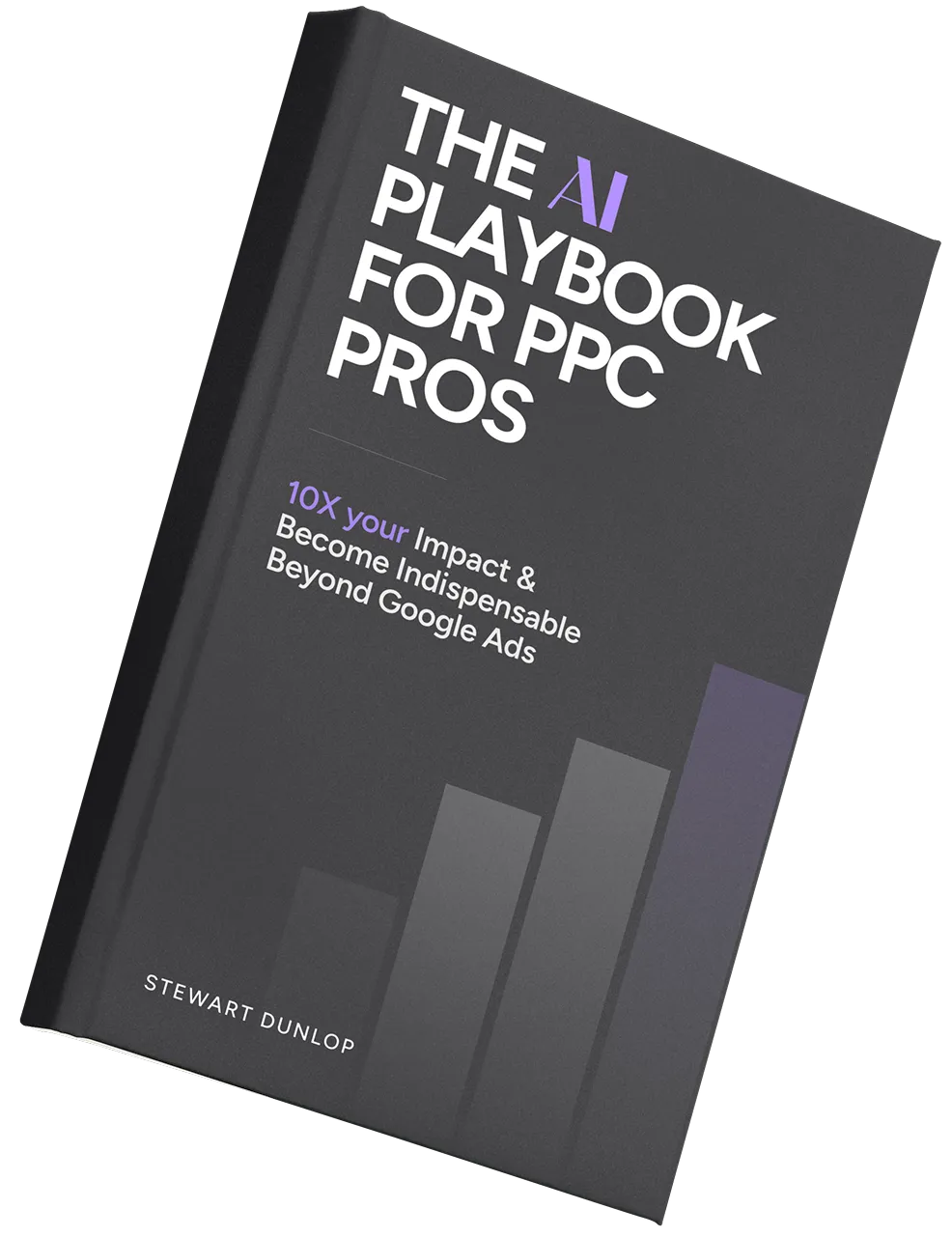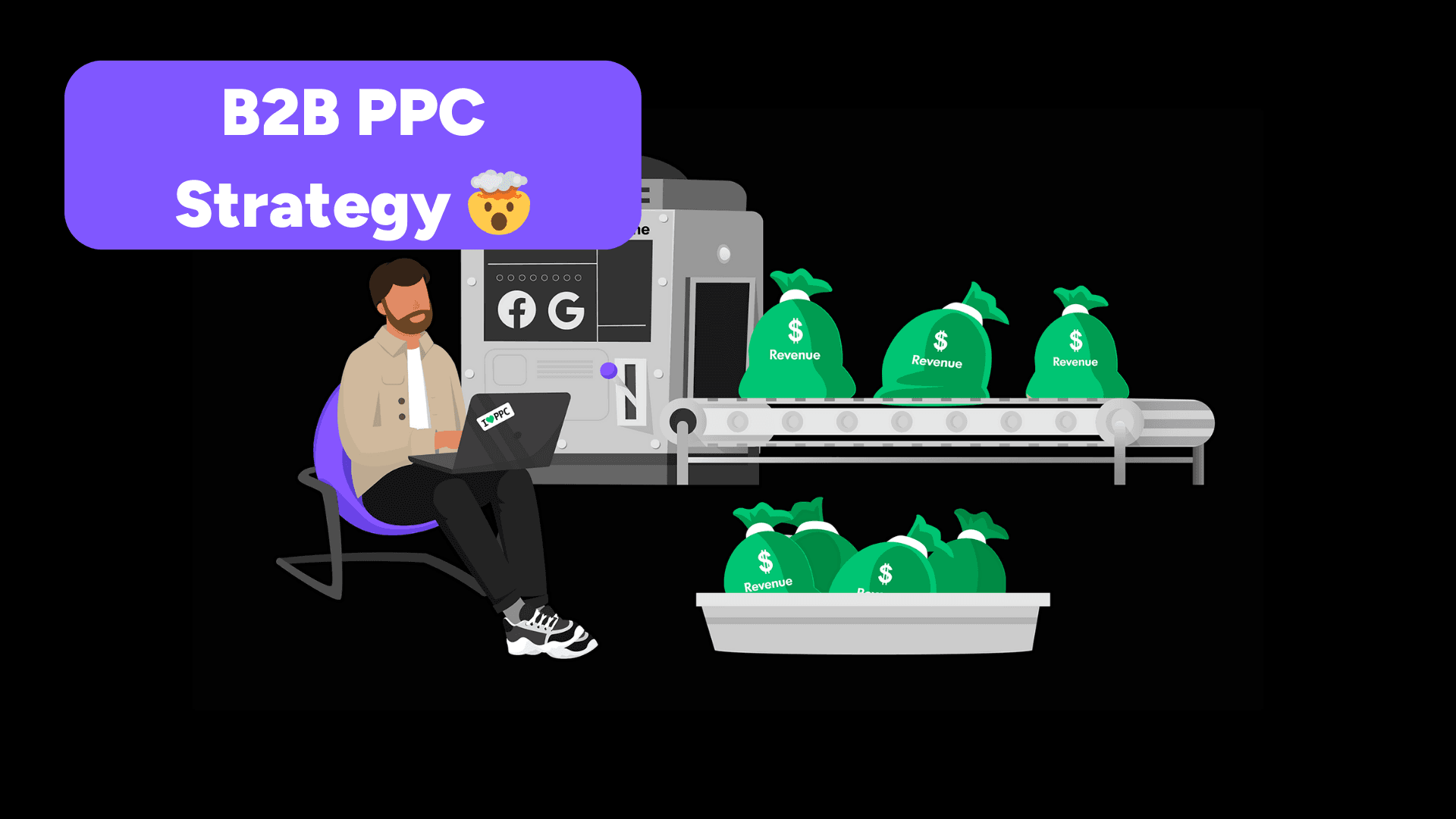
Key Takeaways
- PPC for B2B businesses is a phenomenal strategy for delivering a return on investment from your ad spend.
- It involves accounting for longer decision-making cycles in B2B PPC by nurturing leads rather than pursuing immediate conversions.
- A deep understanding of your B2B target audience is critical for creating high-performing PPC campaigns.
- Choose PPC keywords with high relevance to the search intent of professionals in your target market.
- Ensure your ad content and landing pages are high quality and provide value to your audience for better engagement.
PPC is an incredible channel for growing any B2B business.
72% of B2B decision-makers start their search for solutions online, often clicking on paid ads. This makes PPC an important channel for attracting new customers.
PPC marketing isn’t just about visibility. It’s also about profitability.
Picture this:
🤔 Each click costs $10.
🤔 Your data suggests that for every 50 clicks, you typically gain one client.
🤔 This translates to an investment of roughly $500 in PPC to acquire a single client.
🤔 Now, if that client brings a $300,000 project, the return on your initial spend is immense.
🤑 You’re looking at an ROI of approximately 600 times your ad spend.
These figures are illustrative, and actual outcomes can vary.
Yet, it's clear that PPC advertising can yield insane returns, particularly in the B2B sphere, where contract values tend to be higher and the sales cycle is longer.
In this article, we explore the benefits of PPC for B2B businesses and provide you with a roadmap for launching a successful campaign right from the start.
What Is B2B PPC?
It’s simply advertising (typically on Google) where the user pays a fee when their online ads are clicked.
So, for example, if someone types in “Online marketing consultant” and clicks on your advert, you’ll pay Google a one-time fee for that click, e.g. $10-20.
The competition (and costs) can get fierce, but that’s because PPC works for B2B brands.
How PPC Can Help Your B2B Business
The reason it’s such a powerful tool is because it can deliver results instantly..
⏩ Immediate and measurable results
🖱️ High potential for targeted clicks
🔎 Precision targeting for your ideal B2B customer
💸 Flexible budgeting to match your marketing spend
🎯 Re-engagement with visitors at different stages of the sales funnel
The Challenges
It's important to understand some of the unique challenges that come with this type of advertising. We’ve listed some of the examples below.
➡️ The size of your target market
Target markets in B2B sales tend to be smaller than those of B2C companies.
This means that your keyword searches won’t always have high search volumes.
For instance, way more people search for "nike running shoes" (as you can see below, with 96,000 monthly searches) than for a specialized term like “environmental compliance software” (with 100 searches a month).


This means that you need to be more specific when you target your audience.
For example, here’s the ad that we saw when we typed “Nike running shoes” into Google:

Their target market is runners, so it hones in on some general preferences runners might have, including:
- Comfort
- Speed
- Distance
Someone searching for “environmental compliance software” would have much more specific needs, as shown in the examples below.

As you can see, the search result is really specific. Many people outside the IT engineering sector will have no idea what this means.
Rule of thumb: the smaller the search volume, the more specific you need to be in your ad and landing page content.
➡️ Diverse decision-makers
In B2B PPC, your target audience could be anyone employed in a company, from the CEO to an IT person, or even an accountant.
Typically 6-10 people are involved in B2B companies decision-making.
This could include:
- The CEO
- The CFO
- Procurement managers
- Company directors
- Frontline managers
- IT managers
Successful B2B PPC ad campaigns will target the people most likely to respond to a PPC campaign.
This affects everything from keywords to ad copy and landing pages—don't worry, we cover this later in the article.
For example, if you work with start-ups then you would probably target CEOs and explain how you can help them scale their business.
➡️ The B2B buyer's journey
When it comes to significant investments like new software or machinery, B2B buyers don’t make decisions quickly.
So, these types of sales can take anywhere from 3 to 6 months or more.
Successful PPC campaigns address this by using key terms that target different stages of the marketing funnel. This allows businesses to give potential customers the information they need at each step of their buying process.
Generally, this buying process (also called the buyer’s journey) has 3 stages:
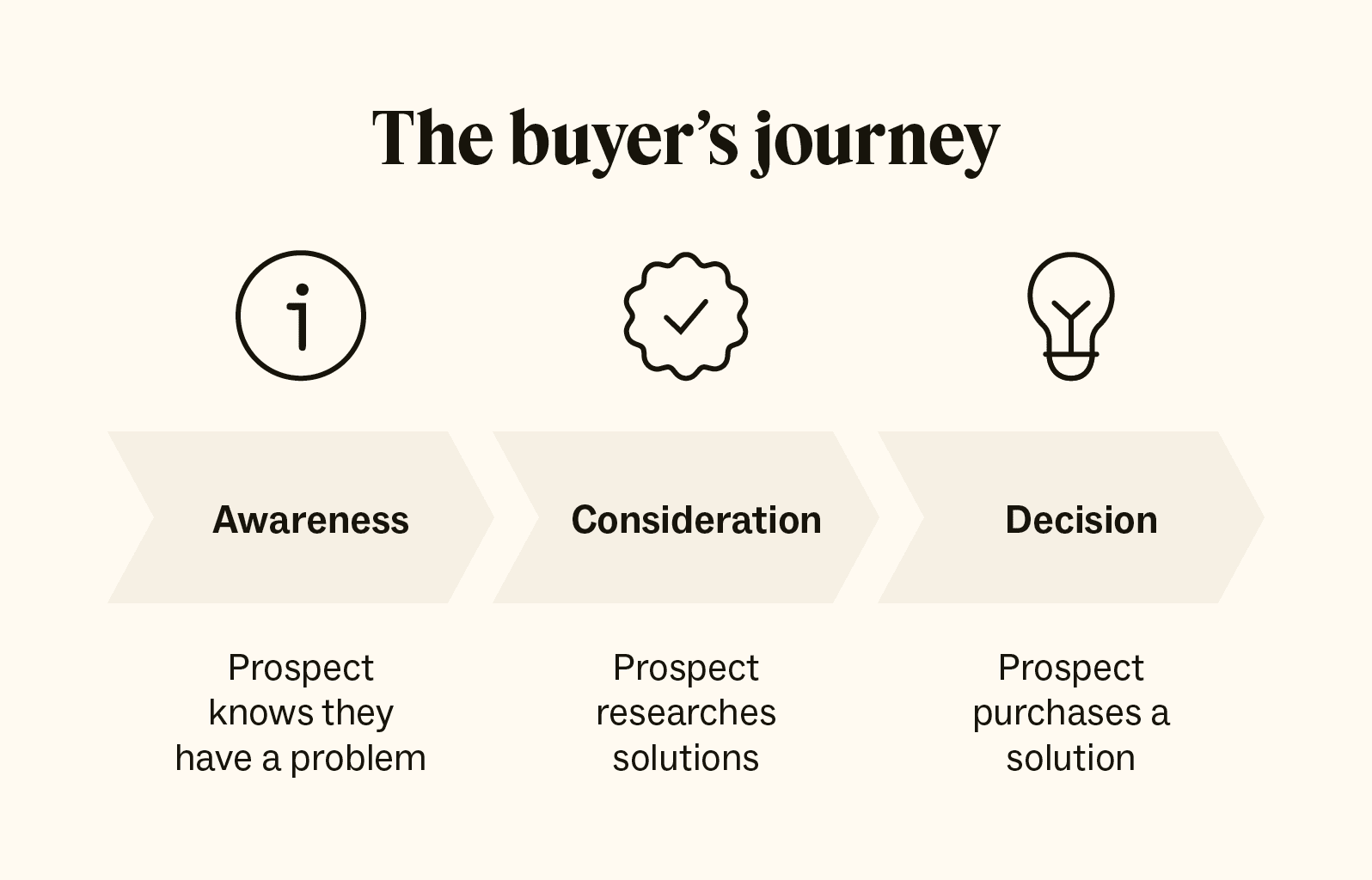
ⓘ Awareness stage: Top of the funnel (TOFU)
At this initial stage, a business recognizes a need or identifies a problem. It's the starting point where they seek basic information and insights about potential solutions. We explore some examples later in the article.
📊 PPC strategy: Ads targeted at this stage should focus on raising awareness about your brand and providing informational content that introduces your solutions.
✅ Consideration stage: Middle of the funnel (MOFU)
The buyer understands their challenge and starts evaluating different solutions, products, or services. It involves in-depth research and a comparison of options.
📊 B2B PPC strategy: Your ads should highlight your product's specific benefits and features, setting it apart from competitors.
💡Decision stage: Bottom of the funnel (BOFU)
This final stage is when the buyer is ready to make a purchase. They may interact with sales representatives, request quotes, or explore demos.
📊PPC strategy: At this point, PPC ads should be focused on conversions, encouraging actions like product demos, trial sign-ups, or direct inquiries.
Aligning your PPC campaigns with each stage of the buyer's journey is crucial for effective B2B marketing.
This ensures that your advertising content is relevant and appealing, guiding potential leads through the funnel toward a purchase decision.
How to Get Started with B2B PPC Campaigns
Now that you know the benefits and challenges of B2B PPC, let’s get to the fun part—setting up your campaigns.
1️⃣ Research your audience
Start by defining the characteristics of the businesses you are targeting. Consider factors like industry, company size, and the decision-makers within these businesses.
When targeting B2B companies, your audience might include managers, executives, or professionals like IT directors or procurement officers.
Another critical step is understanding what products they currently use and how yours is different or better. This helps you explain why they should switch to yours.
2️⃣ Understand your objectives
Once you have a clearer understanding of who you are targeting, the next step is to dig deeper into what your business aims to achieve.
Let's take a look at a few common B2B goals:
✅ Generating leads
If your main goal is to generate leads, your PPC B2B campaign should focus on capturing the contact information of potential clients.
This means your ads and landing pages should be designed to encourage sign-ups, downloads of whitepapers, or try a free trial.
This ad for Monday.com’s CRM software is a good example. This ad offers users the opportunity to try the software for free.
To get this template, a user must provide Monday.com with their contact details. This information is likely added to a list of leads for the sales team to follow up on.
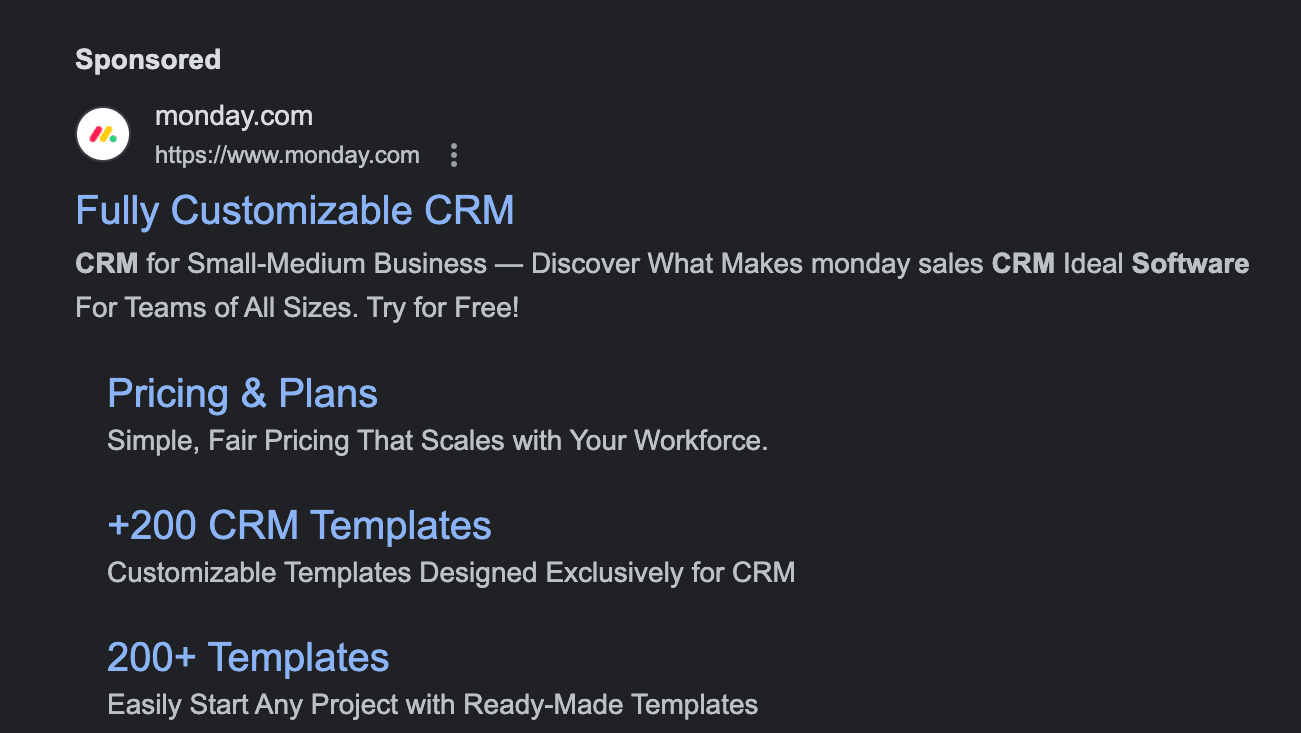
✅ Building brand awareness
Brand awareness is a key objective in many campaigns. PPC ads are effective tools for broadening your reach and highlighting your brand’s unique values and solutions.
Take the Zoho ad below. It focuses on its primary benefit: improved customer relationship management.
It also highlights its global popularity, while also mentioning some of the benefits that it knows its customers want.

✅ Content promotion
B2B buying cycles are typically longer than those in B2C industries.
One of the reasons for this is that business buyers often review over 10 pieces of content before making a decision.
PPC is an excellent way to help engage potential customers by aiding their decision-making.
You can use it to help them find valuable resources like whitepapers, case studies, or webinars.
A practical example is this ad from Insightly, a CRM platform that offers a free comparison guide via PPC ads, helping potential customers in their vendor selection process.

3️⃣ Ensure your landing pages are optimized to convert
Most (but not all) PPC campaigns link to a dedicated landing page on a company’s website.
Successful B2B landing pages are optimized to:
✔️Generate leads
✔️Educate prospects
✔️Build trust
✔️Drive specific actions
✔️Create brand awareness
A good landing page can also boost your ad rank score and make it more likely to be shown to search engine users.
It’s important to ensure your landing page has content that is relevant to the ad and your audience. It should also look professional.
💡What Is an Ad Rank Score?
Ad Rank in Google Ads determines your ad's position on the search results page and how much you pay per click.
It's influenced by several factors:
- Your bid amount: How much you're willing to pay per click.
- Ad relevance to the keyword: How closely your ad matches the search query.
- Quality of the ad: This includes the ad's content, creativity, and how it engages users.
- Landing page quality: The relevance and user experience of the web page your ad leads to.
The ads that score the highest based on these factors are displayed at the top of the search results. Ads with lower scores may appear further down or not at all.
So, before you start any form of PPC advertising, you must ensure your landing page(s) are up to scratch.
To show you what we mean, let's use our example from above, “CRM software.” One of the top results is for a company called Accelo.
This landing page for their CRM software ticks all the boxes when it comes to B2B landing page best practices.
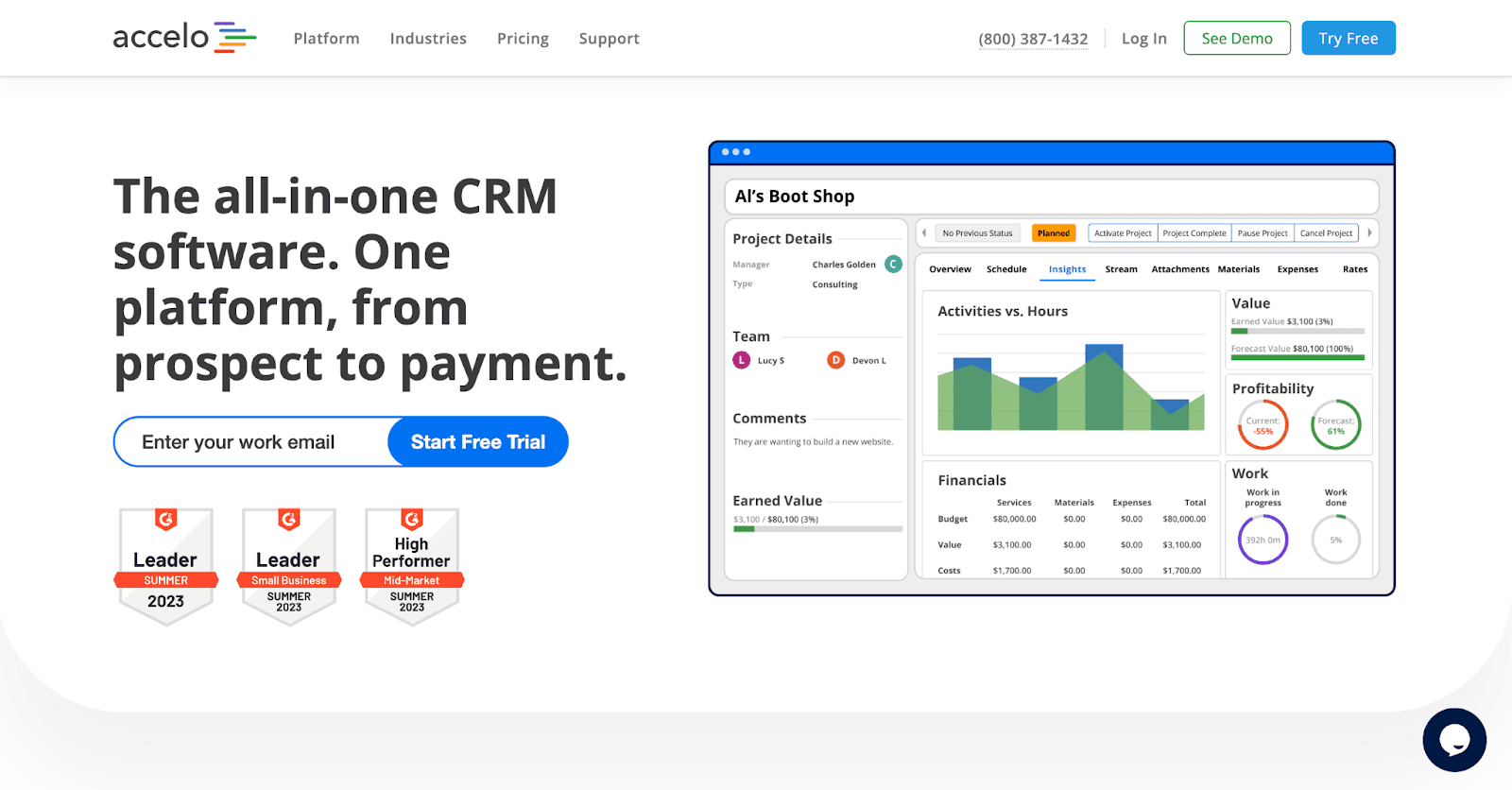
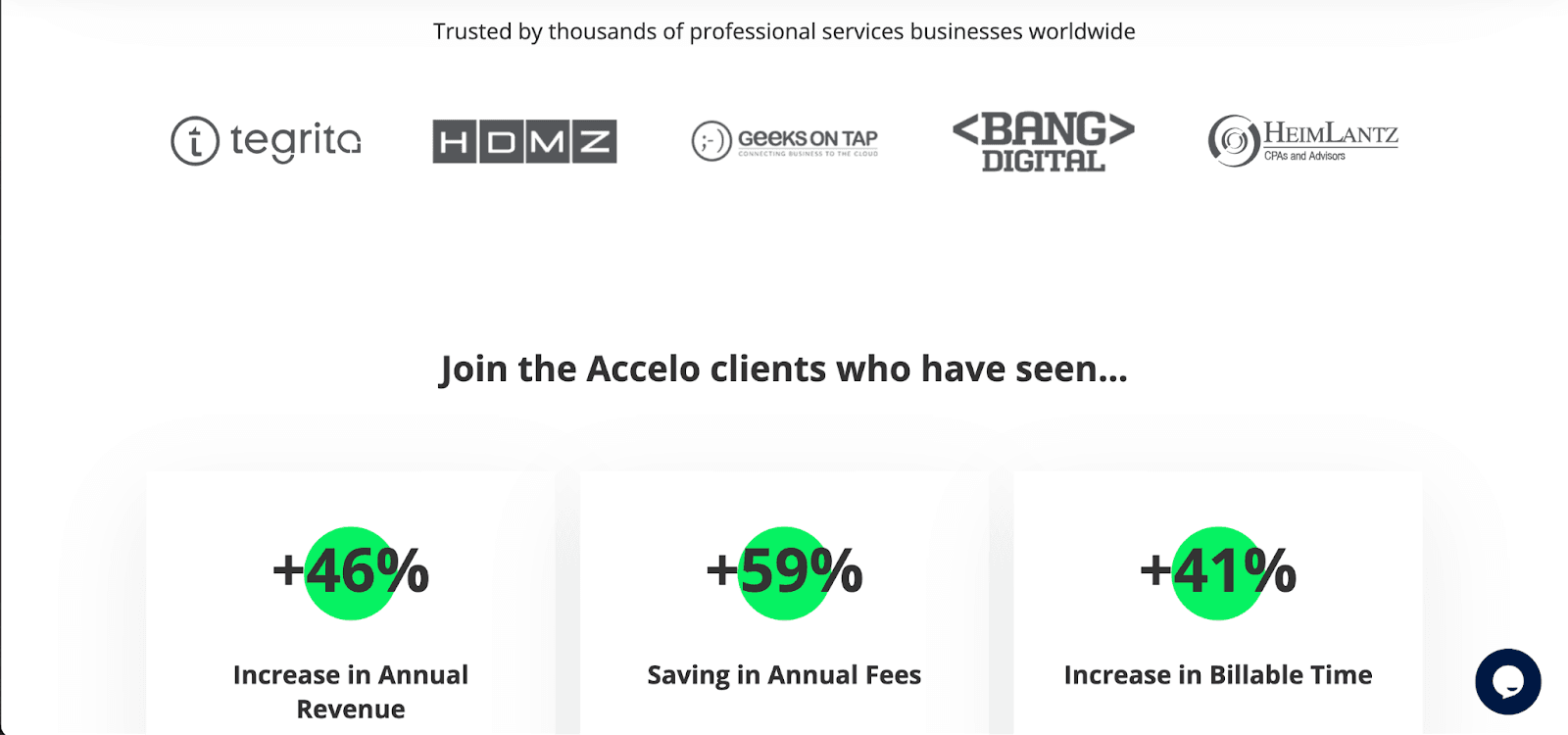
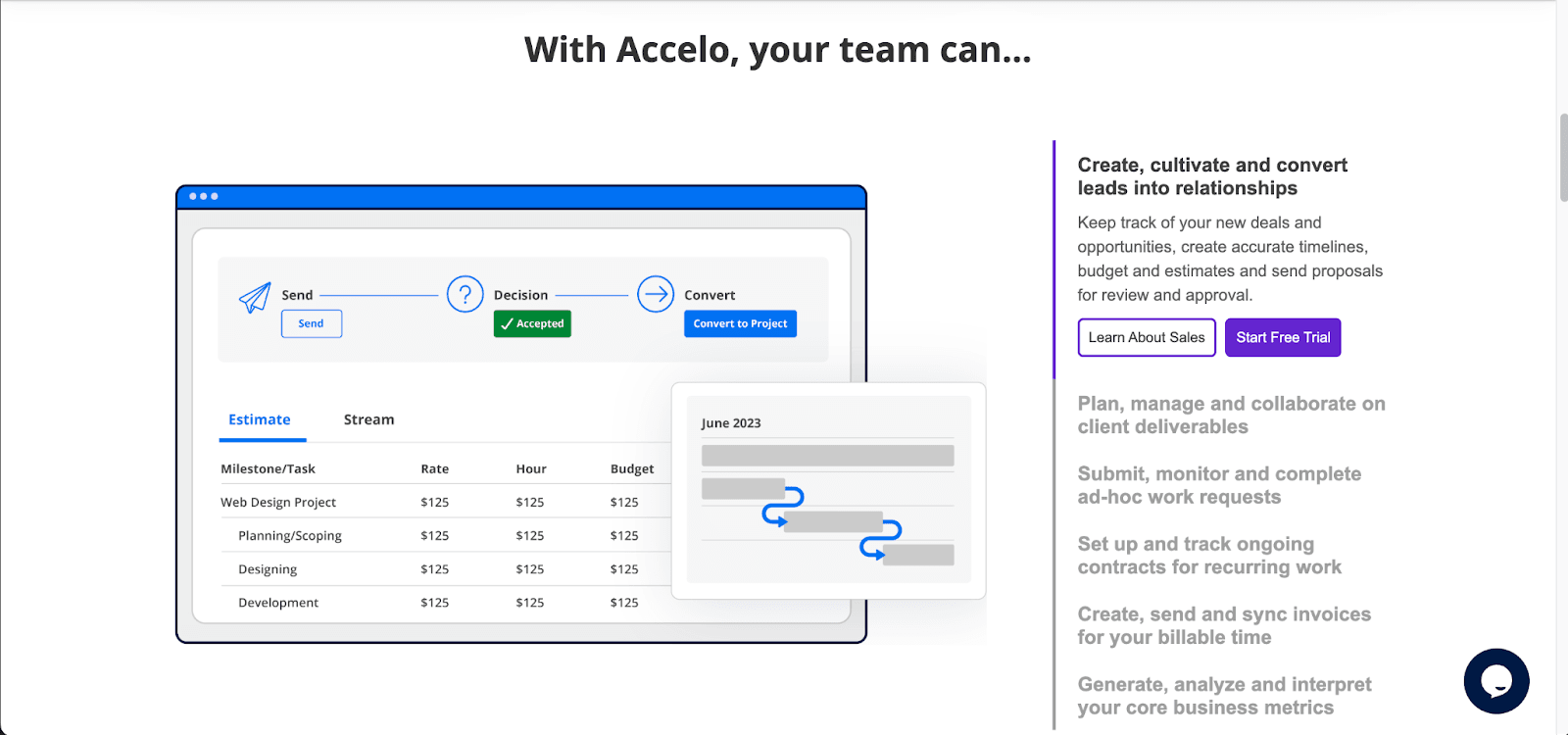
Here’s why this page works:
🎉 Focused call to action: The purpose of B2B landing pages is to encourage visitors to respond to your call to action (CTA). Accelo shows potential leads exactly what they need to do on the page—sign up for a free trial. They make this as easy as possible by providing a form for you to enter your email address.
🎉 Unique value proposition: Right up top, Accelo has told you why they are better than the competition. They provide a comprehensive solution to manage sales from prospecting to payment.
🎉 The benefits: Further down the page, potential buyers can easily scroll through the features of the software and learn how it can benefit their business.
🎉 Trust signals: Accelo has also placed trust signals above the fold. You can see three recent awards as soon as you land on their page. This builds trust and credibility right away.
4️⃣ Create your Google Ads account
If this is your first PPC campaign, you will need to set up your Google Ads account to get started. The good news is it’s completely free.
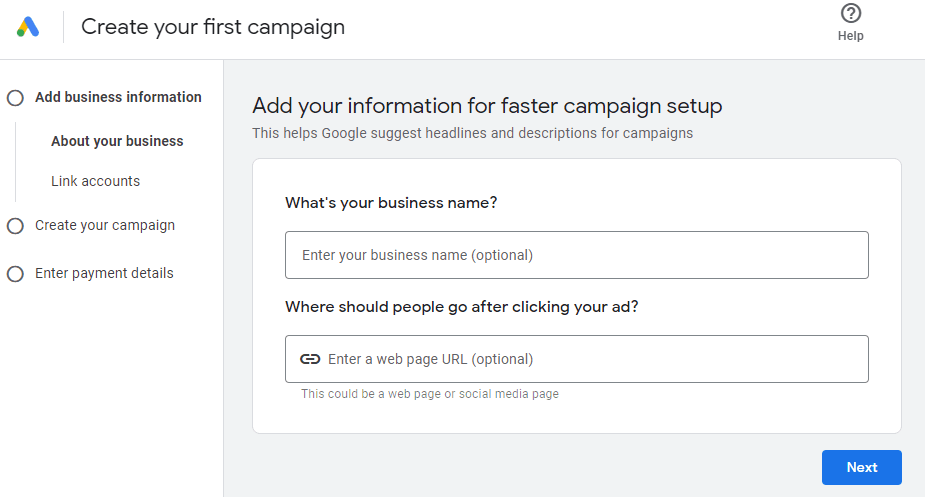
This process is quite simple and only requires a few steps to create your account and get your campaign up and running.
You’ll need to provide:
✅ Information about your business
✅ Details about your campaign goals and budget
✅ Your credit card details
5️⃣ Set up your target audience
You can set up your PPC ad to only be displayed to specific potential clients.
You can target demographics like:
- Location.
- Age.
- Gender.
- Household income.
- Interests.
- Search terms they are likely to use.
For example, if you're offering cloud-based CRM solutions to mid-sized tech companies, target professionals aged 30 to 50 in tech hubs like San Francisco, Austin, or New York.
Refine your targeting to include those interested in cloud computing or CRM technologies, which ensures that your ads reach key decision-makers likely in need of your services.
6️⃣ Select your keywords
Based on your thorough understanding of your audience, you will need to consider the words or phrases your ideal client is likely to type in when they visit Google.
To get this step right, you must do keyword research with tools like Google Keyword Planner, Ahrefs, or SEMRush.
Below is a dashboard from Ahrefs, a keyword research tool:
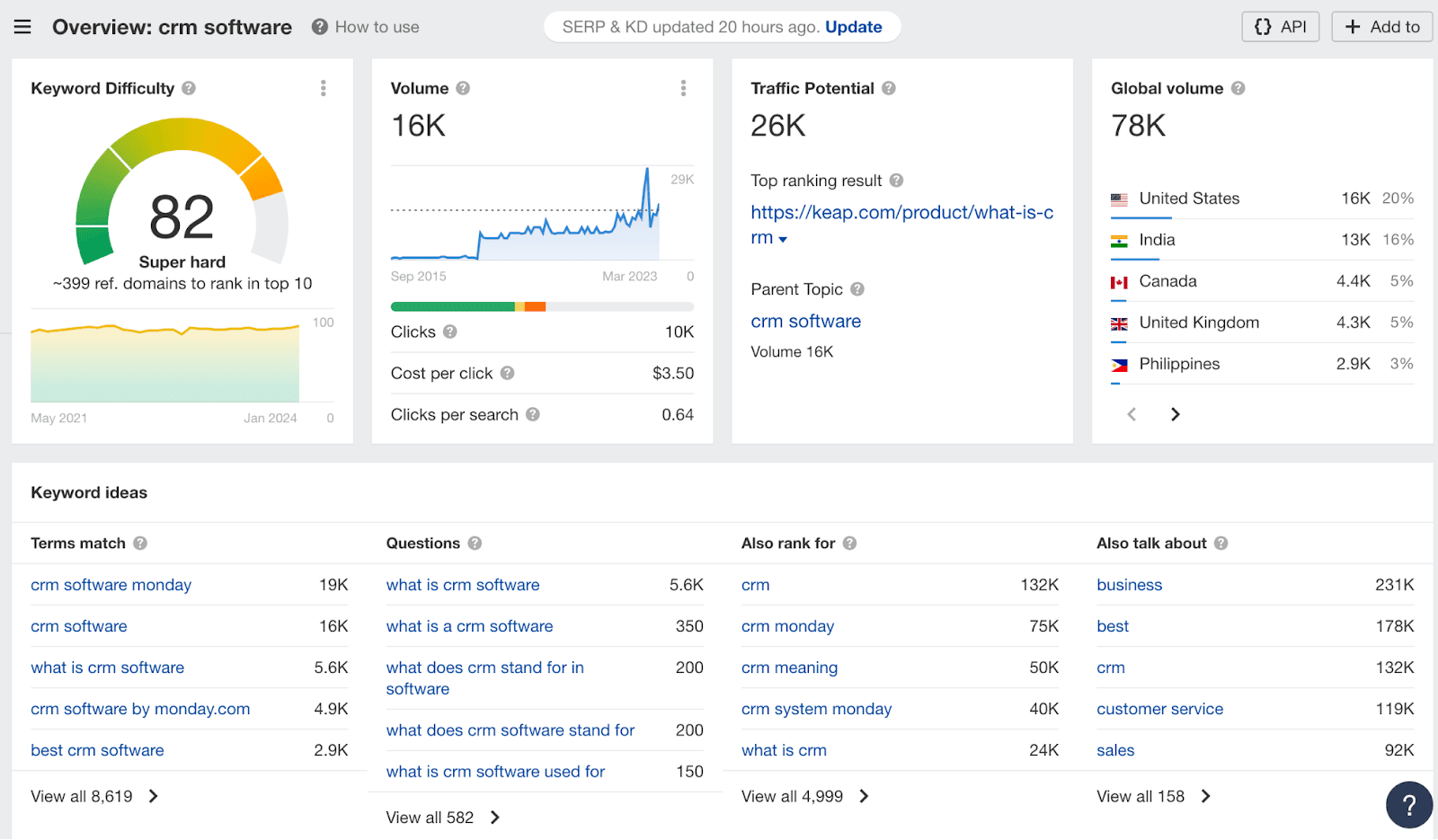
Let’s break down the main metrics and how you can use them to choose keywords:
💡Keyword difficulty score: Indicates the probability of ranking organically in the top 10 search results. A score of 82 for "CRM software" suggests high competition. While not directly impacting PPC, it hints at the keyword's competitiveness.
💡Search volume: This shows the average monthly search volume for the keyword in specific countries or globally (78,000).
💡 CPC (cost per click): Shows the average cost for each paid click, useful for budgeting.
💡Keyword suggestions: Offers related searches, questions, and terms to expand your keyword list.
Generally, you need to find keywords that:
✅ Are relevant to what your business offers.
✅ Show strong buyer intent.
✅ Are Affordable: Cost per click (CPC) measures the estimated amount you’ll pay per click for this term.
✅ Get lots of searches: This is usually called volume or traffic.
✅ Aren’t too competitive: As the name suggests, keyword difficulty in Ahrefs indicates how difficult it is to rank for a keyword organically. Google Ads refers to this as keyword competitiveness.
How B2B PPC Keyword Selection Differs
B2B PPC campaigns adhere to the general principles of keyword selection but differ in a few ways due to the unique nature of B2B transactions.
We’ve mentioned some of them already in this article.
It’s about choosing words that:
✅ Indicate buyer intent
As mentioned earlier, B2B purchases are typically more considered and involve multiple stakeholders.
Therefore, keywords must cater to every stage of the B2B buying cycle, from awareness (informational) to consideration (comparative) and decision (transactional).
For CRM software, an example could be:
- Awareness: "What is CRM software."
- Consideration: "CRM software comparison."
- Decision: "Best CRM software for large enterprises."
✅ Consider cost-effectiveness
Remember that B2B transactions often justify higher costs due to the substantial value of each conversion.
Let’s illustrate this using our earlier example:

The term “enterprise CRM” costs $6.00 per click. Compare this to the term “nike running shoes” which has a CPC of $0.40.

“Enterprise CRM" might have a higher CPC than “nike running shoes”, but while the latter makes around $120 per sale, a CRM sale could be worth thousands of dollars per year.
✅ Focus on targeted search volume
Instead of chasing the highest search volumes, aim for specific, niche keywords that promise more qualified leads, even if they have lower search volumes.
✅ Balance competitiveness
Avoiding highly competitive keywords is a common strategy, but for B2B, some level of competition is expected.
We recommend focusing on long-tail keywords that are specific to your business offerings.
Let's use the example of enterprise CRM. Here are some long-tailed keywords related to this niche.
🔎CRM solutions for large businesses
🔎Top CRM systems for enterprises
🔎Scalable CRM software
🔎Customizable enterprise CRM
🔎Best CRM for large companies
🔎Advanced CRM tools for business
🔎Cloud-based enterprise CRM
🔎Enterprise CRM with AI capabilities
✅ Use negative keywords to your advantage
When managing PPC campaigns for enterprise CRM software, negative keywords are as crucial as your primary keywords.
Negative keywords prevent your ads from showing up for irrelevant searches, saving you money and ensuring better quality leads.
For instance, if you're focusing on "enterprise CRM solutions," you might want to add negative keywords “Free CRM,” “CRM for small businesses,” and “basic CRM” to avoid attracting individuals looking for low-cost or small-scale solutions.
💡How Do You Find Negative Keywords?
When conducting your keyword research, type in your main CRM-related keywords and analyze the search suggestions and terms that come up. Look for terms that are not relevant to your product or service.
Add these irrelevant terms to your negative keywords list in your Google Ads campaign. This ensures that your ads won't be triggered when someone searches using these terms.
➡️ Create separate campaigns for each stage of the sales funnel
We have found that creating different ad campaigns for each part of your funnel allows you to align your messaging, targeting, and calls-to-action with the specific needs and mindset of users at each step.
Here's a breakdown of what your ad campaigns could look like at each stage:
Top of the funnel (TOFU)
Objective: Create brand awareness by providing educational content.
Ad content: Use eye-catching headlines that give the reader valuable content to help them achieve something. For a product like CRM software, this could be a guide to what CRM is or a comparison of different types of CRM offerings.
CTAs and offers: Offer valuable resources like e-books, white papers, or checklists. These should be designed to engage audiences who are not yet familiar with your brand or solutions.
Keywords: For ads targeted at the top of the funnel we’d recommend including terms that are used when seeking information.
This is especially important in the B2B space, where the buying cycle involves a lot of research.
For CRM software, you’d expect keywords like:
🔍“What is CRM"
🔍"CRM benefits for businesses"
🔍"How CRM improves sales"
An example is this ad by SAP. We came across it while searching for “what is CRM software.” It links to a landing page that contains a guide to what CRM is, its benefits, and the key features of CRM software.
This ad could have been improved by explicitly mentioning the guide in the ad copy.

Middle of the funnel (MOFU)
Objective: Build credibility and showcase your unique selling proposition.
Ad content: Highlight the features and benefits that set your product apart. Focus on what makes your solution better than others.
CTAs and offers: Encourage deeper engagement with content like case studies, product comparisons, or webinars. This stage is all about building trust and establishing your product as the best solution.
Keywords: Middle of the funnel (MOFU) in your PPC campaign means selecting keywords that appeal to audiences who have moved beyond basic awareness and are now actively comparing different solutions.
As an example, for CRM software, this would include keywords like:
🔍"Best CRM for small businesses"
🔍“CRM with email integration"
🔍"Top CRM software 2024"
🔍“Customizable CRM platform"
🔍"B2B CRM software solutions"
Here is an example of an ad from the middle of the sales funnel. It aims to encourage small business owners to find out more about the product. The ad explains how the software can help a small business manage sales.
The landing page explains each aspect of the product in detail.

Bottom of the funnel (BOFU)
Objective: Drive conversions and encourage decision-making.
Ad content: Use persuasive messaging that emphasizes the value and benefits of your offering. Highlight any unique selling points, like pricing or features, that could sway the decision.
CTAs and offers: Employ strong, action-oriented CTAs like “Sign up for a trial,” “Request a demo,” “Request quote,” or “speak to us today.” Consider time-sensitive offers to create a sense of urgency.
Keywords: At this stage of the buyer's journey, we’d recommend targeting keywords that indicate readiness to buy, such as those related to purchasing, pricing, or specific product names.
Here are some examples:
🔍”Buy CRM software”
🔍"CRM software pricing"
🔍“Salesforce CRM”
🔍"Free CRM trial"
🔍"Cost-effective CRM solution"
🔍"Quick CRM implementation"
Below is an ad from Zoho that appeared for the search term “buy CRM software.” This landing page helps a potential user to convert.
Landing pages at this stage should convince users that your product or service will solve their problem and make it as easy as possible for them to convert.
The page includes:
- Detailed pricing information
- A demo sign-up form
- Testimonials from organizations that use Zoho
- A list of integrations
- And a comparison list with similar CRM systems

7️⃣ Create ad copy
Now that you understand that you will need to create ad groups and campaigns for each stage of your buyer's journey, the next step is to create great ad copy.
💬 Writing the ad copy
Start with a strong headline that captures attention by adding your main keyword to ensure relevance.
Follow with a description that weaves in your unique selling proposition (USP), benefits, and differentiators. Your CTA should end the ad on a powerful note and prompt immediate action.
Here’s a simplified structure:
🔺Headline: Grab attention with a benefit-rich headline.
🔺Description: Elaborate on benefits and how you differ from others.
🔺CTA: Finish with a strong, clear CTA.
Tips for B2B ad copy
✅ Be specific: Clearly state what makes your product unique. For instance, instead of “hydraulic cylinders,” specify “hydraulic tie-rod cylinders.”
✅ Prequalify leads with price points: Use phrases like “Starting at $500/month…” to set expectations and filter out those seeking lower-end solutions.
✅ Address pain points: Craft copy that empathizes with the buyer’s challenges and presents your offering as the solution.
✅ Showcase social proof: Leverage Google reviews, testimonials, or endorsements to build credibility.
✅ Use social proof: Terms like “top-rated,” “award-winning,” and “industry leader” enhance trust.
8️⃣ Place a bid
Next, you’ll need to place a bid for your specific keywords in a PPC auction to get your ad to appear at the top of search engine results.
This is also where you get to stipulate how much you are willing to spend on your ads.
💡A bid guides Google on how much you're willing to pay for a click on your ad. Google Ads offers various bidding strategies tailored to different marketing goals.
Each strategy is designed to help you meet specific goals, such as increasing website visits, growing visibility, driving conversions, or getting more views on video content.
Choosing the right bidding strategy depends on your campaign objectives, budget, and the specific actions you want your audience to take.
Here's an overview of the top bidding strategies for B2B PPC throughout the buyer's journey:
1. Awareness stage
As we mentioned above, this stage is about increasing brand awareness among potential customers who are beginning to recognize their challenges.
Recommended bidding strategies:
📈Target impression share: This strategy lets you choose how often your ads appear in certain spots on search results pages. It's used to boost brand visibility and audience reach by displaying ads more often. It's useful for staying top of mind with potential customers who are early in their research phase.
📈Maximize clicks: An automated bid strategy that sets your bids to help get as many clicks as possible with your budget. It's useful for driving traffic to informational content that helps build awareness around your solutions.
2. Consideration stage
The objective here is to engage potential customers who are actively researching solutions to their problems and are considering various options.
Recommended bidding strategies:
📈Manual CPC bidding with enhanced CPC (ECPC): This Google Ads strategy allows you to set maximum cost-per-click (CPC) bids manually, but allows Google to adjust these bids up or down based on the likelihood of a sale or conversion. This means you can target more specific keywords related to your solutions and adjust bids for searches that are more likely to convert.
📈Maximize conversions: This strategy allows you to automatically adjust your bids to get as many conversions as possible, ideal for driving webinar sign-ups, whitepaper downloads, or free trial registrations, which are common actions in the consideration stage.
3. Decision stage
This stage is about targeting potential buyers who are ready to take significant action, like requesting a demo or contacting sales.
Recommended bidding strategies:
📈Target CPA (cost per acquisition): A bidding strategy that automatically adjusts your bids to get as many conversions as possible with your set budget. Google uses historical data and machine learning to predict which clicks are likely to convert, making it ideal for capturing high-intent leads at a stage where the customer is ready to commit.
📈Target ROAS (return on ad spend): Ideal for campaigns where you can estimate the value of a conversion and aim to achieve a specific return on ad spend. This strategy works well when you’re focusing on the value of new customer acquisitions or upsells.
📈Maximize conversion value: This strategy works like target ROAS without the specified return on investment (ROI).
9️⃣ Start tracking your PPC campaign
Tracking your B2B PPC campaigns is essential to understanding their performance and optimizing them for better results.
Here’s how you can effectively track your PPC campaigns:
1. Set up conversion tracking
Start by setting up conversion actions in Google Ads. This involves adding a snippet of code to your website to track actions such as form submissions, downloads, or specific page visits.
Next, define what constitutes a conversion for your business—whether it's a lead form submission, a product demo request, or a whitepaper download.
2. Implement Google Analytics
Link Google Analytics with Google Ads: Connect your Google Ads account to Google Analytics to get detailed insights on user behavior, such as how long users stay on your site, the pages they visit, and the path they take before converting.
Set goals in Google Analytics: Create specific goals in Google Analytics to track conversions that originate from your PPC campaigns. This can include tracking both macro (e.g., sales) and micro (e.g., newsletter sign-ups) conversions.
💡Pro-tip: Set Up Google Ads Auto-Tagging
Google Ads auto-tagging is a feature that automatically adds a special tag to the URL of your ads. When someone clicks on your ad, this tag tracks what happens after the click.
It allows for more accurate and comprehensive reporting in Google Analytics. You can see how your Google Ads traffic is behaving on your site, such as the pages visited, time spent on the site, and conversion actions taken.
Benefits of conversion tracking
✅ ROAS measurement: By tracking conversions, you can calculate the return on ad spend for each ad group, helping you to allocate your budget more efficiently.
✅ Optimization of campaigns: Understanding which ad groups perform better allows you to optimize ad spend by focusing on the most effective groups.
✅ Insight into customer journey: Tracking conversions helps you understand how customers interact with your ads at different stages of their buying process. It also helps you to understand which of your content and messaging resonates with your potential leads.
✅ Enhanced lead quality: Over time, conversion data can reveal which ad groups bring in higher-quality leads, allowing for more targeted marketing strategies.
💡Pro-tip: ROAS stands for "return on ad spend." It's a metric used in digital marketing to measure the effectiveness of an advertising campaign.
ROAS tells you how much revenue you earn for every dollar you spend on advertising.
Here's a simple way to understand it: If you spend $1 on ads and get $5 in sales from those ads, your ROAS is 5.
This means that for every dollar you’ve spent, you got five dollars back in revenue.
🔟 Retarget
Retargeting in B2B PPC is a way to reach people who've already shown interest in your business.
Maybe they visited your website but didn’t complete a download or fill out a form. Retargeting shows your ads to these users as they browse the web or use social media.
Setting up retargeting
- Track your visitors: Place a pixel, a small piece of code, on your website. This tracks visitors and allows your ads to "follow" them online as they browse the internet.
- Segment your audience: Not all visitors are the same. Some might have checked out a product page, while others might have just landed on your home page. Create different ad messages for the different parts of your sales funnel.
- Choose your platforms: Decide where you want to run your retargeting ads. This could be on Google’s network, social media platforms like LinkedIn, or other websites.
Why retargeting works in B2B
Retargeting keeps your brand in front of potential customers over time.
By reminding visitors of what they viewed on your site, retargeting can nudge them closer to taking action.
You can customize your ads based on what each visitor looks at on your site, making your messages more relevant.
Feeling a Little Overwhelmed?
While understanding your audience for B2B PPC can be a lot of work, it doesn’t have to be overwhelming.
This is where PPC.io comes in. As a dedicated PPC management company, we specialize in navigating these complexities for you.
Our team can help dissect your target audience and craft tailored PPC campaigns that resonate with each decision-maker in your business sphere.
Let PPC.io take the wheel so you can focus on what you do best—running your business. Reach out to us today to simplify your PPC strategy.
Advanced Strategies to Level Up Your B2B PPC Campaigns
If you are ready to take it up a notch, join us as we dive into some advanced B2B PPC strategies below.
Advanced strategy #1: Set up dynamic search ads to fill in keyword gaps
Dynamic search ads (DSAs) are a type of Google Ads campaign that automatically generates ad headlines and landing pages based on the content of a website.
Google scans your site and identifies keywords relevant to your business. It will then automatically create ads to target them.
Benefits of DSAs
✅ Saves time: DSAs save a lot of time since there's no need to manually create lists of keywords or write detailed ad copy for all possible relevant searches. The system automates this process.
✅ Broader reach: They allow you to cover a wide range of user searches that you might not have anticipated in your keyword research.
✅ Improved relevance: DSAs are tailored to the user's search query, making the ads more relevant to the searcher. This can lead to higher click-through rates (CTR) and better overall campaign performance.
Key considerations
⚠️Website dependency: DSAs perform best with well-optimized, content-rich websites.
⚠️Reduced keyword control: Automatic keyword generation means less control over which searches trigger your ads, which could occasionally lead to less relevant traffic.
Advanced strategy #2: Leveraging LinkedIn Ads for targeted account-based marketing
Account-based marketing (ABM) shifts the focus of PPC campaigns from a broad audience to specific, high-value companies or individuals.
It's about precision, targeting those most likely to benefit from your product or service.
LinkedIn, a professional network, is ideal for B2B ABM efforts. It allows targeting based on job roles, industries, company size, or specific organizations.
Implementing LinkedIn ABM
✅ Identify your targets: Select companies that are prime candidates for your offerings.
Identify key players within these companies, such as decision-makers or influencers.
✅ Create tailored content: Design ads that speak directly to the challenges and needs of your targeted audience.
✅ Offer value-driven content: Ensure your ads deliver tangible value. This could be through custom demos, industry-specific whitepapers, or case studies.
Here is a LinkedIn ad offering a valuable piece of content on how small businesses can be more productive.
Interested readers can access this content by clicking the ad and providing their contact details, creating a direct engagement opportunity.
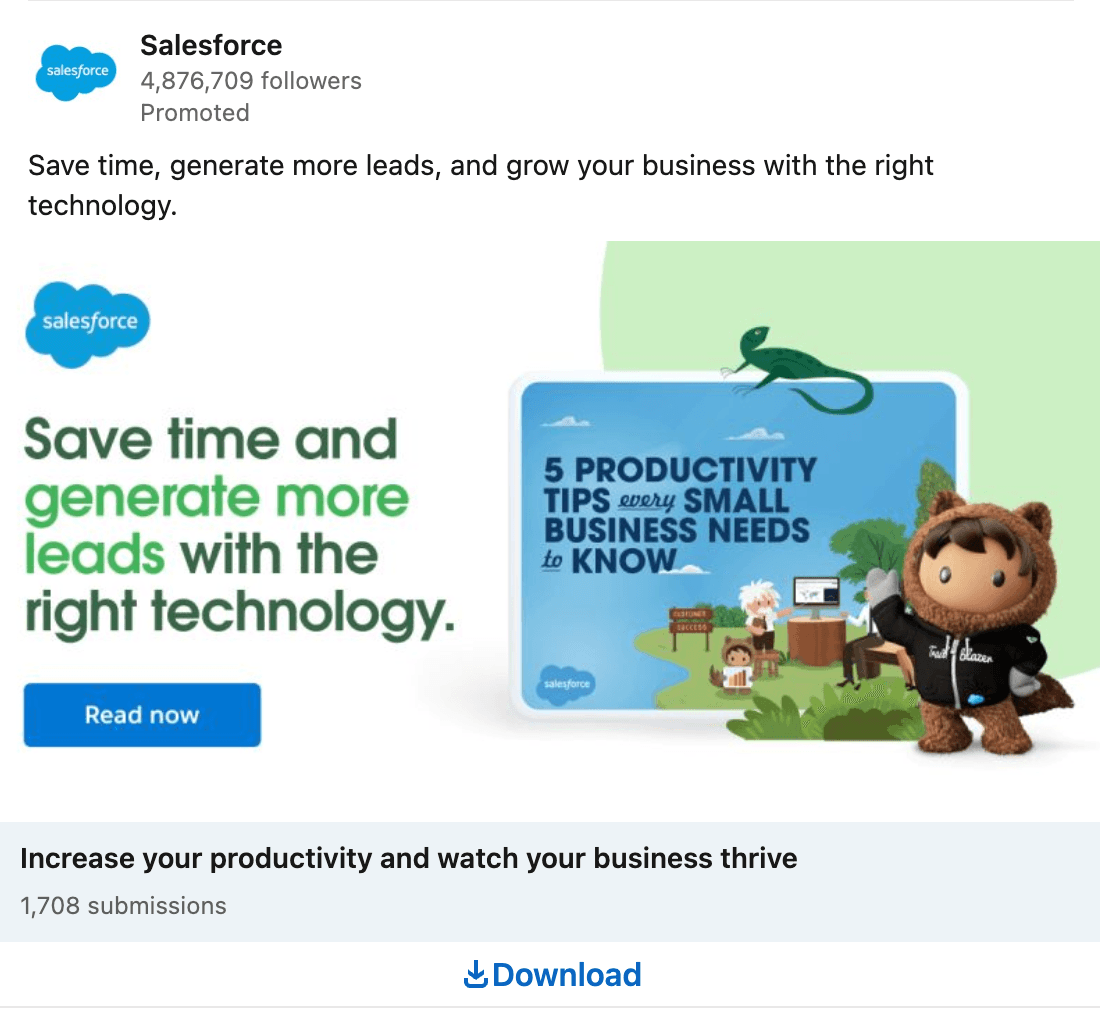
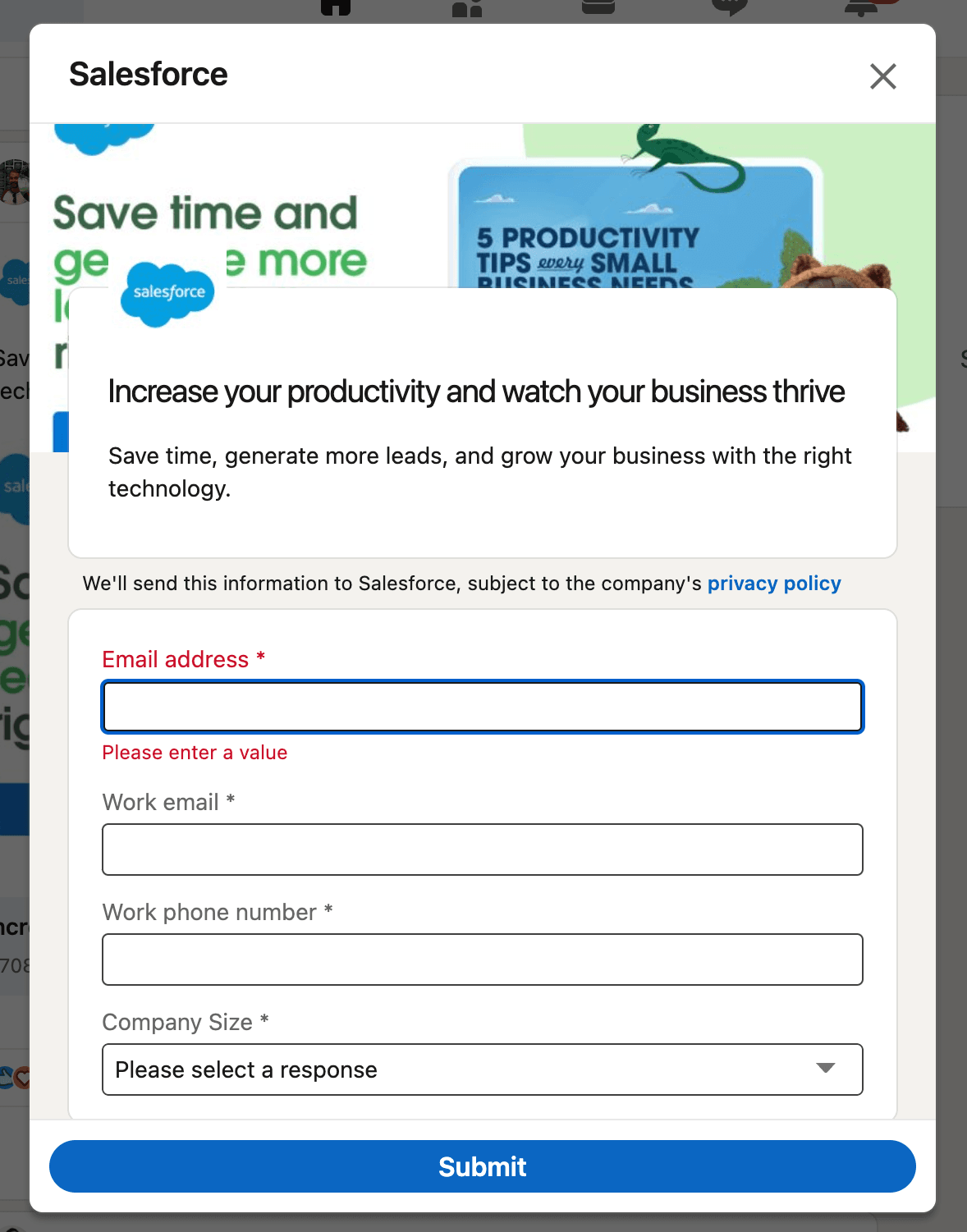
Advanced strategy #3: Utilizing custom intent audiences in Google Ads
Custom intent audiences allow you to target people who are likely interested in your products or services based on their recent online behaviors.
Essentially, you can create a list of keywords and URLs related to what you're offering, and Google will show your display and video ads to users who have shown interest in those topics through their searches, website visits, and content they've interacted with.
This feature allows you to engage potential customers at critical points in their buying journey, enhancing the overall impact of your B2B ad campaigns.
Custom intent audiences are grouped under what Google calls "custom list targeting."
How PPC.io Can Help Your B2B Business Succeed
If all this sounds way too complicated to manage yourself, you’ve come to the right place.
At PPC.io, we know that B2B PPC advertising can be complex, and you could make plenty of costly mistakes along the way.
To protect your budget and get the online leads you need, the best idea is to work with an expert PPC agency that knows the intricacies of the game.
We’ve helped many businesses run highly successful PPC campaigns that combine a carefully considered strategy with keyword research, beautifully crafted ad copy, and bidding methods that win results like no other.
If you’re interested in working with us and standing out in the B2B space, visit our website to get in touch.
